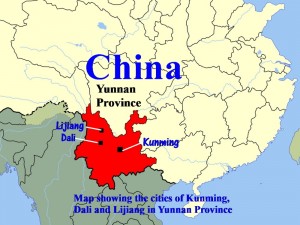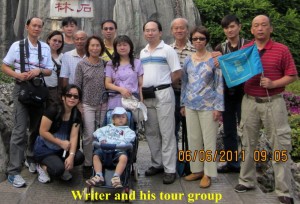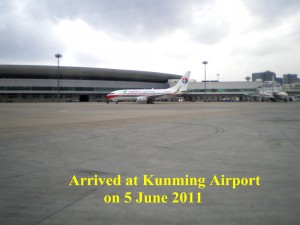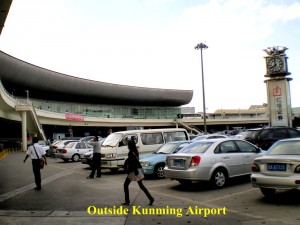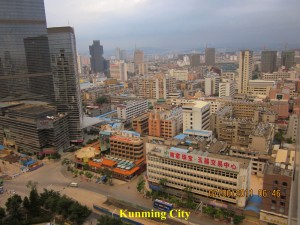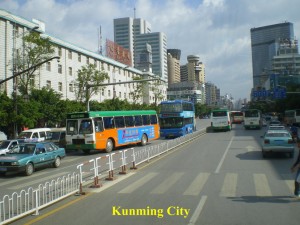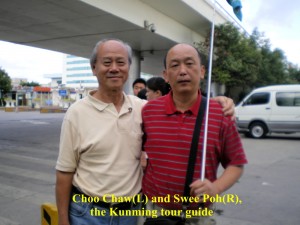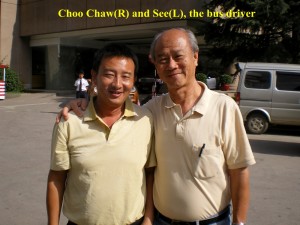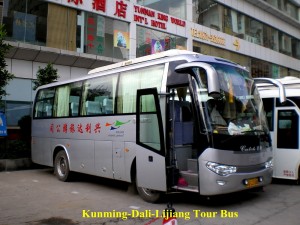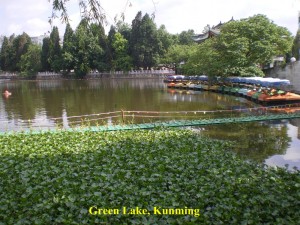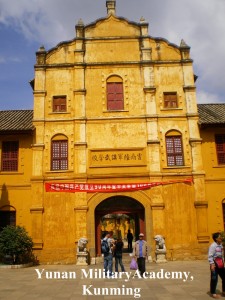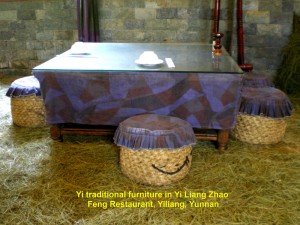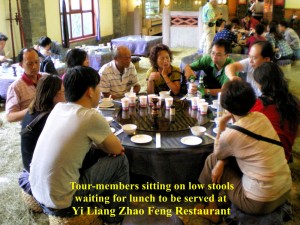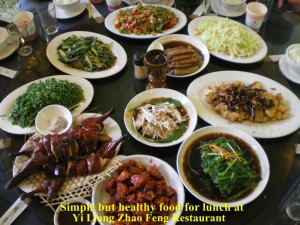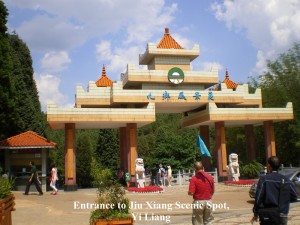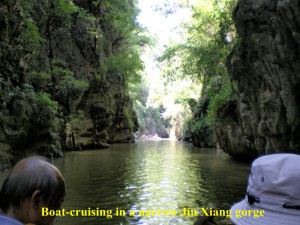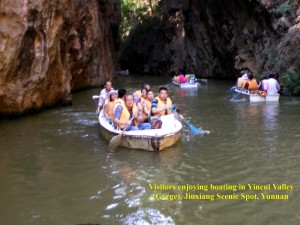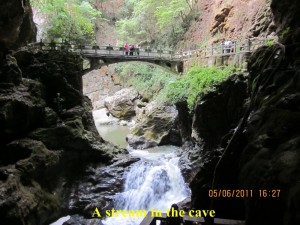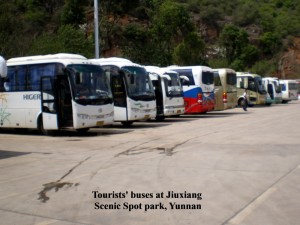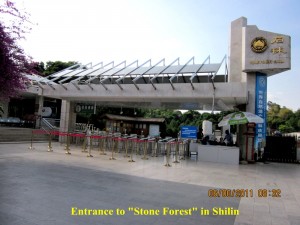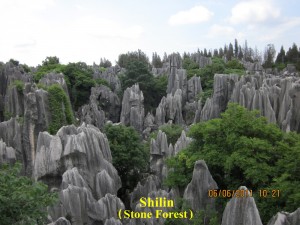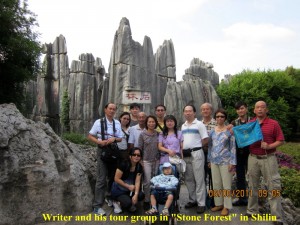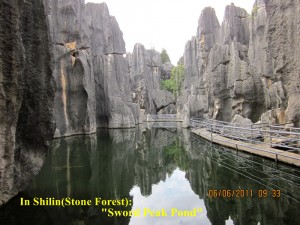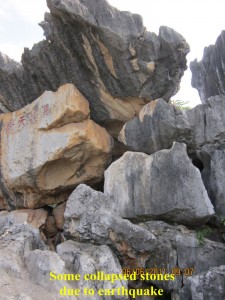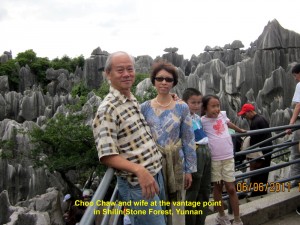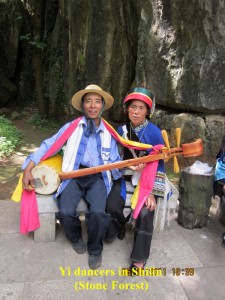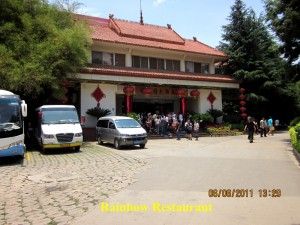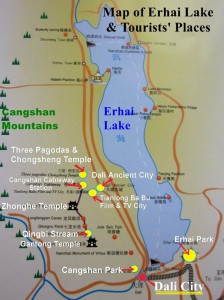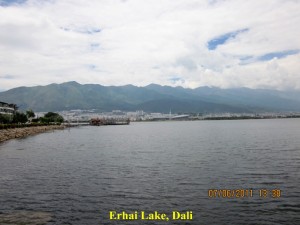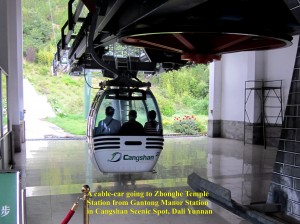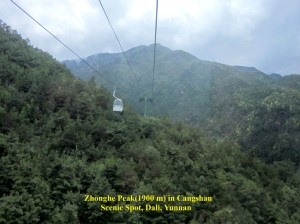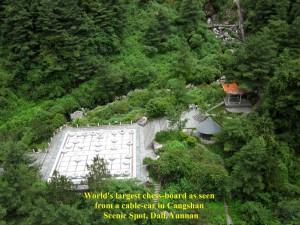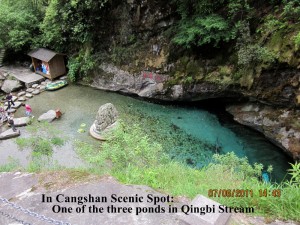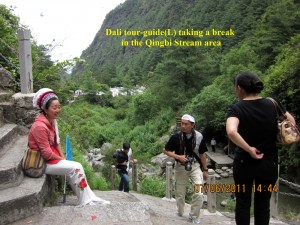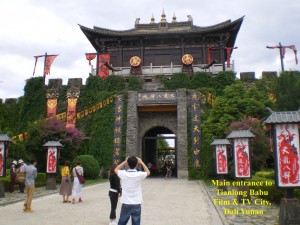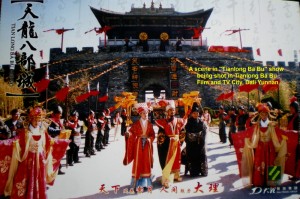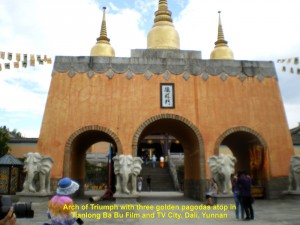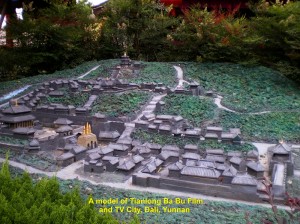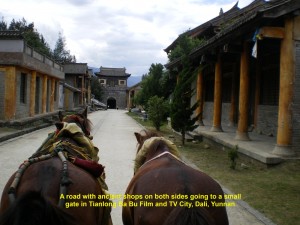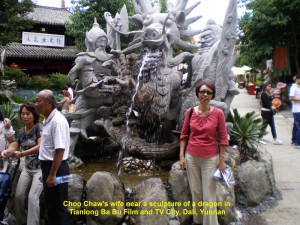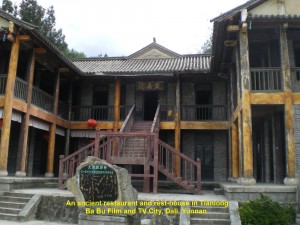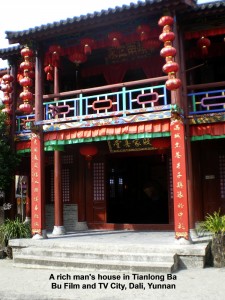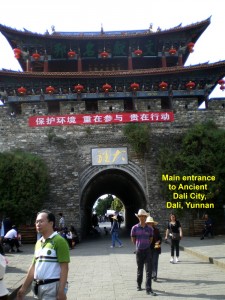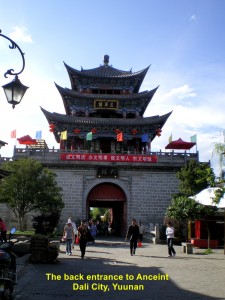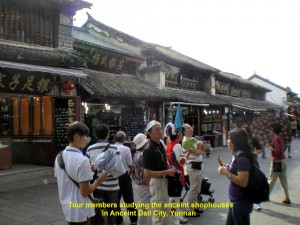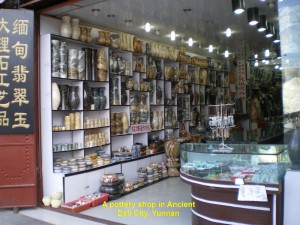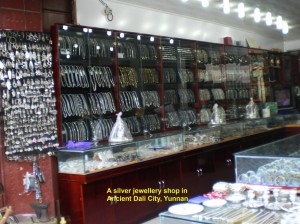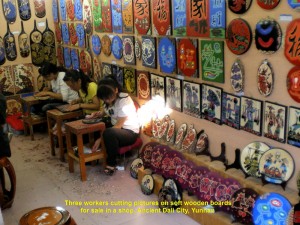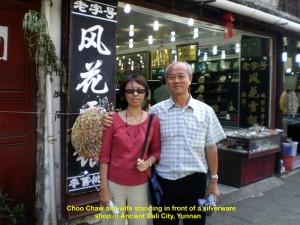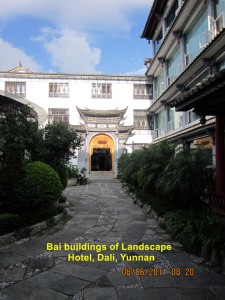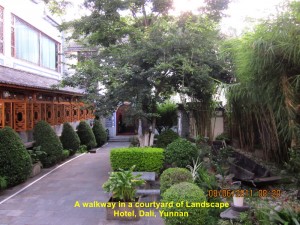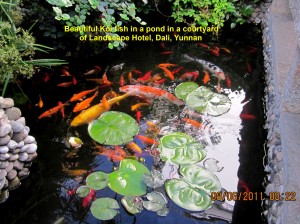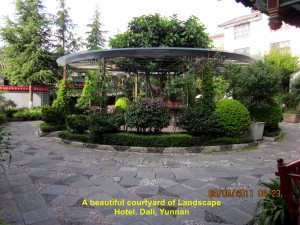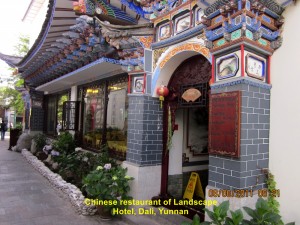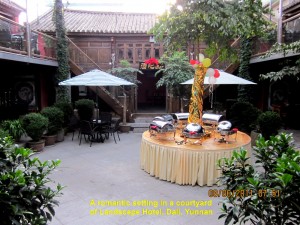Yunnan Travel I (Kunming, Dali)
Yunnan Travel I
Kunming, Dali
Yunnan Attractions
Yunnan is a mountainous province in south China and an interesting region to visit. It is a place where visitors will be amazed by its numerous awesome landscapes, diverse cultures of over 20 ethnic minorities, well-preserved old towns and rich histories.
My wife and I had wanted to visit the province very much. So, we booked a 7-day-tour of three places in Yunnan, viz. Kunming, Dali and Lijiang, at Vacation Hub Travel & Tour Company in Skudai, Johor, Malaysia.
Day 1 Sunday, 5 June 2011
Flying to Kunming City
On 5th. June 2011, my wife and I joined a small group of ten Malaysians led by a young, handsome gentleman, Kent Tay, from Vacation Hub Travel & Tour Company and went to Singapore Changi International Airport.
At about 3.50 a.m., a China Eastern airplane flew us straight from the airport to Kunming City that has a population of over 4.5 millions in Yunnan, China. On arrival at the airport at 6.50 a.m., we went to claim our luggage and then the immigration room. In the room, we were surprised to see lots of people waiting for their turn to get their passports checked and stamped. We had to join the long S-shaped queue.
Queue-Jumpers at Kunming Airport
After queuing for about 25 minutes, my wife and I were behind first four visitors. We thought our turn to see the immigration officers would come within five minutes. But , unfortunately, at that moment a group of about ten foreigners came into the hall and went straight to the front of our queue. One of them told the front persons that they were in a hurry as they had to catch a domestic flight to Shanxi at 8 a.m. We guessed he was not telling the truth, as it was already 7.30 a.m., and they should have boarded their airplane then.
Looking behind us, I was surprised that there were no immigration officers to stop them. Some of us complained, loudly, to the big-sized and tall immigration-officer. He was standing right in front of our queue with his back facing us. But we were exasperated as he did not respond.
As we were noisy, a young, thin officer standing about 15 feet in front of our queue, suddenly, shouted in Chinese. He reprimanded us for making too much noise and asked us to wait patiently for our turn. Besides, he said he and his colleagues were already tired, as they had worked for many hours.
As our complaint had fallen on deaf ears, three brave female visitors who had been queuing behind me went forward and stopped some of the uncivil queue-jumpers from joining their friends. We gave them the thumbs up.
Soon, my wife, I and the other 10 members in our tour group were glad to be out of the Kunming Airport. Outside the airport, we were greeted by a Kunming tour guide, Swee Poh. He asked us to board a medium-sized bus and told us that See, the local bus-driver, would bring us around in Yunnan for 7 days.
Cui Hu Park(Green Lake Park)
The first place in Kunming City, See brought us, was a restaurant in the city where we had our first breakfast in Yunnan. After that meal, we were brought to the city’s old but famous park, Cui Hu Park(Green Lake Park).
Cui Hu Park is a beautiful, large park with a lake of lotus plants surrounded by shady willow trees and flowers. A few ancient, traditional Chinese buildings with rich colours and decorations can be seen within the park. One of them, Haixinting, built a few hundred years ago is on a tiny island in the middle of the lake.
Our tour guide, Swee Poh, told us that the park would be crowded with tens of thousands of migratory red-peaked seagulls from Siberia during winter and spring. As it was summer then, we saw a few local ducks swimming, happily, in the lake.
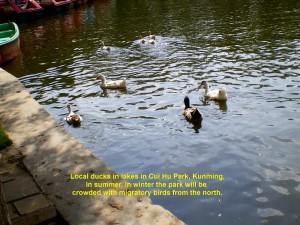
Local ducks in lakes in Cui Hu Park, Kunming, in summer. Migratory birds from the north gather here in large numbers.
Army Military Academy
After an hour of tour of Cui Hu Park, we crossed a busy road to an old dark yellow building which was once an army military academy for local and foreign students. It was founded in 1899 during the Qing Dynasty. After the fall of the dynasty, a new military academy was built to replace the old one.
It had produced many militarists and revolutionists. Now the building is a military museum showcasing the academy history and its achievements. Photos showing military activities in the olden days and military leaders, and some military arsenal relics are displayed in the museum, too.
Later, we went to visit an old temple, Yuantong Buddhist Temple which is not far from the museum.
Yuantong Buddhist Temple
Yuantong Buddhist Temple, located on the southern slope of Yuantong Hill, was built during the Nanzhao period in the late 8th. Century. Having a history of over 1,200 years, it has gone through a lot of reconstruction. Besides, it had changed names a few times. It was during the Yuanyanyou Peiod(1314-1320) that the temple was finally named as Yuantong Temple. Buddhists from far and wide make pilgrimage to this well-known temple.
Yi Liang Zhao Feng Restaurant, Yiliang
After a brief tour of the temple, we left Kunming City and headed 95 km east to a popular tourist destination of a different kind in Yiliang. It is known as Jiuxiang Scenic Spot which is famous for gorges and limestone caves.
On the way to Jiuxiang Scenic Spot, we stopped at a restaurant, Yi Liang Zhao Feng Restaurant, in Yiliang. We entered the restaurant and took our lunch like the way the Yi people usually had their meals. (Yi is a Yunnan ethnic minority.) We sat on low cylindrical-shaped stools round a large low table in a dinning hall. The floor was covered with long, green pine leaves. When food was served on the table we all tucked in and enjoyed the simple but delicious meal.
Jiuxiang Scenic Spot
Then we continued our journey to Jiuxiang. On arrival, we were greeted with some prominent red Chinese characters inscribed on a large rock. They mean that “If you don’t visit Jiuxaing, you need not come to Yunnan”. It implies that tourists should not miss that famous spot.
Jiuxiang Scenic Spot covers an area of 167 sq. km. of highlands, valleys, gorges, rivers, waterfalls and limestone caves. It has six main spots. The spot we visited is the most well-known, i.e. Diehong Bridge Zone.
Yincui Gorge
When we reached Jiuxiang, instead of walking down 300 steps to the bottom of the Yincui Gorge, we took a lift and went down 53 m. The river in the gorge has been raised to a height of over 6m by a dam. On this river, we took a short, slow boat-ride. While boating in the narrow gorge, we marvelled at its steep, rocky slopes.
After the ride, we walked down narrow steps in the steep Yincui Gorge to a large cave. The cave looked like a hall, known as Lion Hall. A concert was held once in that cave. As we went further in, we came across rapids and waterfalls. Besides, we saw some stalactites and stalagmites in a cave that looked like the popular Chinese legendary immortal characters, and the cave is called “Immortals’ Cave”.
Magic or Fairy Field
Walking further into another cave, we saw terraced ponds which looked like a terraced paddy field. That “field” is known as Magic or Fairy Field. When we reached the last cave, we saw lots of bats hanging upside down on its ceiling, and some flying in and out of the cave.

“Magic Fields” that look like terraced paddy fields in a cave of Jiu Xiang Scenic Spot, Yiliang, Yunnan
After going through a series of interconnected cooling and partially lit caves for two hours, we took a cable-chair ride to the place where our bus was waiting. As we had visited so many places in a day on the first day of our Yunnan tour, we felt exhausted. So, after dinner, we checked in and retired early at a downtown hotel known as King World Hotel.
Day 2 Monday, 6th. June 2011
Shilin(Stone Forest)
In the morning, we left Kunming City and headed 83 km east to a place of unusual but stunning landscape. It is a place where lots of tall, grey limestones are standing close to each other. The place looks like a forest. That is why the local people call it “Shilin“ which means “Stone Forest“.
Formation of Stone Forest (Shilin).
According to some geologists, the Stone Forest area was under the sea 260 million years ago. Plants and animals thrived in the sea then. When they died their matters settled on the sea-floor and covered with sediments. Later, under sediment-pressure and high temperature, they became limestone. Subsequently, tectonic plate movement happened and the region was uplifted and became land. Then weathering and erosion took millions of years to sculpture the limestones into the present beautiful shapes.
It was a long journey to Shilin Forest which is 97 km east of Kunming City. On arrival, we were surprised that the place was already crowded with visitors. Swee Poh, our local guide, helped us to explore the stone area for a few hours. We were totally captivated by the stunning and splendid landscape of various shapes and sizes of stones.
As we were walking in the “Stone Forest” we came across a few narrow passages. Some stones had fallen over and others had collapsed due to weathering and earthquake. There were several stones with their top parts fallen onto other stones and resting, dangerously, on them. It was scary to go under these hanging rocks.
While following the trails in the “forest” we saw some stone-structures that looked like animals, e.g. elephants, birds, dragons, etc. The trails criss-cross each other like a maze. Without Swee Poh’s guide, we would have lost our way in that “forest”.
Vantage Point
Finally, Swee Poh brought us to the highest point in the “forest“. It was a pavilion that was built on a rock and commanded a 360 degree view of the “forest” below. We had to climb up steep steps that were crowded with people to reach the pavilion. Standing in the crowded pavilion, we had a breathtaking sight of the forest of stones with some trees growing among them.
Yi Dance
Having spent a few hours enjoying the sights of the unique but strange stones, we stopped for awhile to watch a traditional dance performed by the Yi dancers. In the dance, elderly men were strumming their stringed instruments. They were dancing with a row of women. The dancers were dressed in their traditional costumes of the Yi ethnic minority. A few visitors joined them in their lively dance.
Rainbow Restaurant
Then we left the place for a popular restaurant, Rainbow Restaurant. Our tour-guide told us that there were some shops near the restaurant. According to him, they catered mainly for the domestic tourists, as their things were meant for them.
Tea-Shop
After lunch, we returned to Kunming City. On the way, we stopped at a tea-shop for awhile to learn about some Yunnan tea. It was selling a few kinds of Yunnan tea, like pu-erh, black tea, gold tea, etc. Then some of us bought them for our own consumption, and as presents for our relatives and friends back home.
Tea-Horse Route
Yunnan has been growing tea since over 2,000 years ago. 1,000 years ago, it became well-known for its tea in other regions. Consequently, an ancient tea-route was created to link Yunnan with India via Burma, with Tibet, and with Central China via Sichuan Province. As tea was carried by horses or mules during the ancient days, the route was known as Tea-Horse Route.
“Dynamic Yunnan” Performance at Yunnan Art Theater
In the evening, when we reached Kunming City, we had dinner and then went for a spectacular performance at Yunnan Art Theatre. It was known as “Dynamic Yunnan”.

Choo Chaw and wife posing with a performer of a China ethnic minority at Yunnan Art Theatre, Kunming

Choo Chaw’s wife posing with two performers of Huayaoyi ethnic minority at Yunnan Art Theatre, Kunming
Yang Liping
A famous Chinese performance artist of 30 years’ experience spent several years searching and training a troupe of over 60 performers from different Yunnan ethnic minorities. She is Yang Liping who has created and choreographed the performance that showcases the Yunnan legends, diverse traditions and cultures, and modern dances too. We watched it for one and a half hour. That energy-charged extravaganza filled us and the rest of the audience with awe all the time.
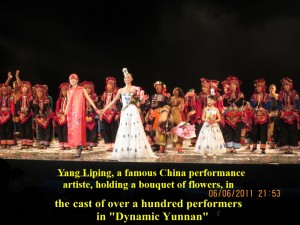
The whole cast including Yang Liping, a famous performance artiste, appearing on stage after the show in Yunnan Art Theatre, Kunming, Yunnan
Day 3 Tuesday, 7 June 2011
Journey to Dali City
At 7.40 a.m. we began our journey to another city, Dali City. It is 240 km west of Kunming City and has a population of over 3.2 millions. The road to Dali City was long, bumpy and dusty. Besides, it was winding and ascending in the first part of the journey. The road went through a few tunnels and an expressway was under construction then. After five hours of bumpy ride and two toilet stops, we arrived at Dali City, safely.
On arrival at Dali City, we were greeted by a lady of Bai ethnic minority, Kim Wah. She was wearing a striking traditional costume. It consisted of a red flowery blouse, pair of white pants with flower-designs and colorful headgear. She brought us straight to a large lake which has a shape of a human ear, and is, therefore, called Erhai(or Ear Sea). We spent a short time at a park by the lake admiring the beautiful scenery of the lake and the mountains, Cangshan, in the distance.
At the park, there is a large, white statue of a beautiful Bai lady. She was supposed to be a fisherman’s daughter.
Cangshan Scenic Spot
Then we went to a mountainous area known as Cangshan Scenic Spot. When we arrived there we took a cable car from Gantong Temple to a height of 2,560 m above sea-level. While ascending in the cable car for a distance of 2,630 m, we had a breathtaking view of the luxuriant Cangshan mountains, V-shaped valleys and Erhai Lake in the distance.
Soon we reached the higher ground and left the cable-cars. Coming out of the station, we saw the world largest Chinese chess board with large concrete “seeds” each weighing 65kg. Each “seed” had a diameter of 1.6 m and thickness 0.5m. The chess board’s length was 21m and width 19m.
Standing on the chess board, I could enjoy looking at the beautiful scenery of the lush-green mountains, a stream, Qingbi Stream, filled with small rocks, pools of turquoise but crystal clear water, V-shaped valleys and Erhai Lake which was far away.
Tianlong Babu Film & TV City
Having spent a few hours in that idyllic place, we descended by cable-cars. Later, we boarded our bus and went to another interesting place nearby.
Located in the centre of the Cangshan-Erhai Scenic Spot, that place was created as a site for shooting movies and TV shows. It was known as Tianlong Babu Film and TV City. It was so named as the first movie that was shot there was “Tianlong Babu”(or “Demigods and Semi-Devils“).
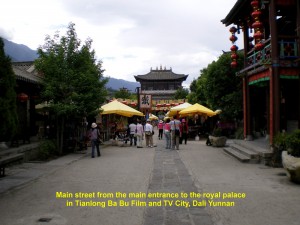
Main street from the main entrance to the Royal Palace in Tianlong Ba Bu Film & TV City, Dali, Yunnan
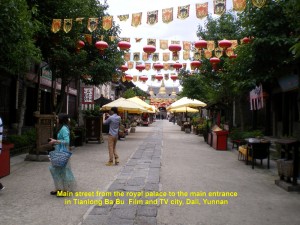
Main street from the Royal Palace to the main entrance in Tianlong Ba Bu Film & TV City, Dali, Yunnan
“Tianlong Ba Bu” Story
“Tianlong Ba Bu” (“Demi-Gods and Semi-Devils”) is a Chinese fiction-novel written by Jin Yong(born in 1924) in 1963-1966. The story is set in the Northern Song Dynasty(960-1127) of China. It is about the “complex, troubled relationships between the great multitude of characters from various empires” including the Liao, Dali, Western Xia and Tibet.
Tianlong Ba Bu Film & TV City Tour
On arrival at the site, my wife and I took a horse-coach ride to tour the place. As we moved along narrow roads, we saw Chinese ancient buildings built, specially, for shooting ancient movies and TV shows. Among them were palace, temple, shops, restaurants, rest-houses and residential houses.
More Photos of Tianlong Ba Bu Film & TV City
Bai Wedding Show
While we were there, we were lucky to watch a Bai wedding show. It was about a rich man who wanted his young, pretty daughter to get marry. So, one day he called all the young eligible bachelors from his village to gather in front of his house. Then his daughter stood on the second floor of his grand house and looked, carefully, for a handsome, young man below. When she spotted one she threw down a red flower-ball to him. He grabbed it and was immediately ushered into the house by the rich man’s servants. He was then dressed like a bridegroom and married the girl.
The picture below shows a girl throwing down a flower-ball:
A Hilarious Wedding Show
But during the actual show, when a girl threw the flower-ball down to a young man, he did not bother to catch it. It just landed a metre in front of him. Nevertheless, two rich man’s servants walked up to him, grabbed him and brought him into the house. All of us, spectators, laughed, loudly, at the way he was handled by the servants. Finally, the man was “forced” to marry the girl. Anyway, the whole show was just an act but we enjoyed watching it.
Ancient Dali City
The next place we visited was the old Dali town. This town, located near Tianlong Babu Film and TV City, is small and was established in the 14th. century during the Ming Dynasty. It was a home to the Bai ethnic minority. Now it is a tourists’ attraction as the town still looks ancient with old architectural buildings, narrow streets paved with stone-slabs and two large ancient gates, North Gate and South Gate.
In the town, the main street of 100 metres long, Fuxing Road, runs from the North Gate to the South Gate. There is a street known as Yangren Street(Westerners’ Street) that has new buildings of ancient Bai architecture. Cafes and western food are sold in some of these buildings.
Other ancient buildings in the town sell goods ranging from souvenirs, clothing, food, beverage to pottery, antiques and silver jewellery. Walking in this old place did give me a feeling that I was living in the olden days.
More Photos in Ancient Dali Town

Visitors taking a photo with the Chinese lengendary Monkey King and Pigsy in Ancient Dali Town, Yunnan
Landscape Hotel, Dali
After the tour of the small, charming, quaint Old Dali Town, we went for dinner and checked in at a hotel known as Landscape Hotel. This hotel’s buildings look like the Bai buildings with white walls and grey roofs. There are many plants growing at the hotel. Besides, it has a beautiful courtyard with a pavilion and fish ponds in its compound. Indeed, the hotel lives up to its name, i.e. Landscape Hotel.
(continued on Yunnan Travel II)
Written by Choo Chaw, Kluang, Johor, Malaysia

